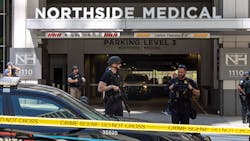Healthcare facilities have always been a high-risk environment for physical security threats. But some experts believe the significance of those risks in healthcare haven’t gained the notoriety seen with attacks on schools or other targets – until now.
Deion Patterson, 24, walked into Northside Hospital in Atlanta’s Midtown neighborhood on May 3 with her mother, who said he was having some kind of mental break and wanted a specific anxiety medication prescribed, The Associated Press says.
When hospital staff declined, Patterson pulled out a handgun and shot several people – killing one woman and injuring four others – before fleeing the hospital and sparking an hours-long manhunt.
Eleven months ago, 45-year-old Michael Louis entered the Natalie Medical Building on the campus of St. Francis Health System in Tulsa, Okla., and opened fire on patients and medical staff, killing four people before dying of a self-inflicted gunshot wound.
Authorities said Louis blamed an orthopedic surgeon there for continued pain after back surgery, and he wanted a specific kind of treatment but apparently was not receiving it.
The International Association of Healthcare Security & Safety (IAHSS) released a crime survey in 2022 found that the rate of murders, rapes, robberies and aggravated assaults at U.S. hospitals increased 47% in 2021.
In a November 2022 memo to participating hospitals, the Center for Medicare and Medicaid Services (CMS) spoke to the high level of violence currently being experienced in hospitals, as well as expectations to address and hopefully mitigate it.
“Healthcare as an industry has always been a huge leader in workplace violence events, but only recently is it getting the recognition for that,” says Bryan Warren, President of security consulting firm War-Sec Security and former Director of Corporate Security for Carolinas HealthCare System. “There is potential for infant abduction, assault of mostly female staff, and theft of hazardous, sometimes nuclear, materials. It was thought of as part of the job for many years.”
He says 74% of assaults that occur in all industries occur in healthcare, which is one of the reasons regulatory and accrediting agencies are stepping up interventions.
“We’ve made great strides in the last few years, and part of that is the sheer magnitude of the workplace violence incidents that have emerged,” Warren says. “If people don’t feel safe at work, they’ll leave. We don’t want to spend time and resources only for good employees to leave when we could make them feel safer.
Duty of Care
Lisa Terry, Chief Development Officer for workplace violence solution provider Vistelar, says there are unique environmental considerations associated with healthcare organizations and that affect security efforts.
Most of them have open access to the public 24/7 and individuals arriving at the facilities, “vary in their situations and possess heightened anxiety and frustration levels,” Terry says.
Terry pointed to a study conducted by Daniel L. Schwerin, Jeff Thurman and Scott Goldstein, National Library of Medicine Active Shooter Response, released in February that emphasized that most hospital shootings are not random but personal and targeted.
Fifty percent of the time, the shooter and victim have known each other, the study found, and many of the incidents are due to a personal grudge against the ex-spouse, doctor, nurse or a colleague.
In addition to hardening the physical environment and training staff on response actions during an active assailant event – such as learning to “escape, barricade, or defend” -- staff should also be trained in non-escalation, Terry notes.
“Treating patients and each other with dignity and respect sets the stage for managing conflict,” Terry says. “Staff have a duty to provide care, as well as to protect the vulnerable patient.”
Flashpoint for Violence
Clients in a behavioral health or healthcare setting will have strong emotions and some unpredictability, along with the typical aversion to going to a doctor, Warren says.
Patterson’s mother, Minyone Patterson, said in an interview with The Associated Press he wanted to be prescribed the anxiety medication Ativan. But his Veterans Affairs medical team declined to give it to him, fearing he could become addicted, according to the report.
The suspect’s mother said Patterson had “some mental instability going on” from medication that he began taking a few days earlier, The AP reported.
“With the unfortunate lack of psychiatric care in the country right now, that is a bad mix,” Warren notes. “Refusal for medications is a potential flashpoint for violence.”
One of the biggest issues, Warren believes, is many patients are coming in with undiagnosed behavioral issues with no treatment history. The pandemic created a divide between the previous and brand-new populations of mental health patients.
“People lost their health, loved ones, jobs, and homes during the pandemic, and that new school of patients lack coping mechanisms and an understanding of the process, which results in violent outbursts,” Warren says.
“We may need to consider some kind of threat assessment process. There is a push for mandatory workplace violence committees or threat assessment teams to include high-risk patients. If they have a known history of violence, there may be some opportunities for additional nonpunitive security measures like additional screening. Some precautions can be taken based on the information you have to mitigate these issues.”
Ben Scaglione, Associate Principal for acoustic design and technology consulting company Cerami & Associates, says healthcare institutions can reduce the possibility of violent situations by assessing access control systems to restrict access in certain situations, provide state-of-the-art CCTV systems so that they can effectively surveil facilities and recall video. He also suggested healthcare facilities use video AI to help identify potentially violent situations.
“Most importantly,” Scaglione notes, “better train healthcare staff to identify potentially violent persons and learn to better handle these types of situations. Healthcare institutions need to have the capacity to better care for mental health patients, increase security system capabilities and better train and drill staff on violent incident prevention and response.”
Steps for Mitigating Incidents
Lisa Terry, Chief Development Officer for workplace violence solution provider Vistelar, says there are many schools of thought regarding preventing and responding to active assailants/shooters. She shared four ways to mitigate these types of events:
- Create a culture that prioritizes respect and safety. This may be accomplished through conflict management training that prioritizes respect, dignity, violence prevention and non-escalation. One training program offered by Vistelar is the Unified Conflict Management Program. Some healthcare organizations have developed a “Patient Code of Conduct.” There are leading practice plans, guidelines and training programs developed by the International Association of Healthcare Security and Safety (IAHSS). Terry recommends every healthcare organization have membership with the association. Additionally, the American Hospital Association (AHA), AONL, ASHRM and the ENA have programs which speak specifically to creating safer workplaces and mitigating violence.
- Harden Public/Main Entrances and Leverage Technology and Design. Unfortunately, Terry says, it’s essential that attention is given to hardening the physical environment within and outside of hospitals and healthcare facilities. IAHSS has produced a document, “IAHSS Security Design Guidelines for Healthcare Facilities,” which speaks specifically to the physical environment. This document has been endorsed by the American Society of Healthcare Engineers (ASHE) and the Facilities Guidelines Institute (FGI). Some examples of hardening the environment include ballistic-rated workspaces in security-sensitive areas, electronic access control and visitor management systems, security incident tracking, video surveillance that includes license plat readers and body-worn cameras and robotics.
- Address Risk Factors and Manage Threats. It is important, Terry says, to conduct ongoing comprehensive threat assessments and security vulnerability assessments to identify opportunities for improvement. It’s recommended that consideration be given to outsourcing these assessments when possible to maintain objective viewpoints and leading practice recommendations. It’s also important to develop a formal threat management program within the organization, Terry adds.
- Train, Train, and Train Some More. Terry emphasizes that there are dangers associated with untrained individuals that include risky independent actions to protect themselves vs. actions of a coordinated team approach. Training should begin with non-escalation, de-escalation and crisis management. Train on workplace violence prevention and response before adding the active assailant/shooter training, she says. Consider conducting realistic simulation exercises with the help of police and other first responders and focus on repetition and building muscle memory while simultaneously preparing for a change in response based on the situation. Terry also suggests utilizing the “safety huddle” to conduct ongoing scenario-based and dynamic training. “When developing response plans,” she adds, “give consideration to potential reactions by staff, visitors and patients based on prior experiences, such as military service or law enforcement.”
John Dobberstein is managing editor of SecurityInfoWatch.com and oversees all content creation for the website. Dobberstein continues a 34-year decorated journalism career that has included stops at a variety of newspapers and B2B magazines.




